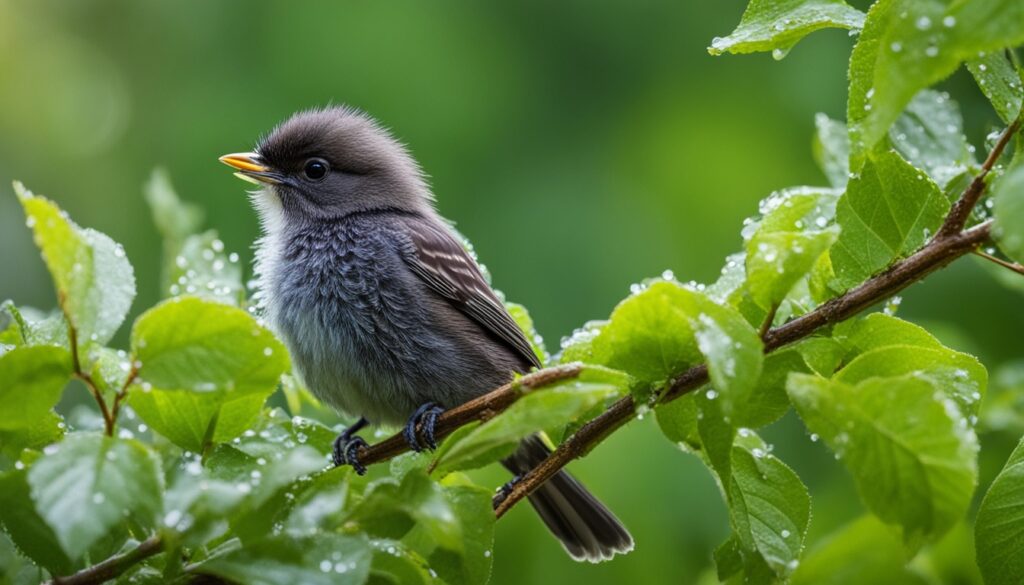Altricial baby birds need to be fed every 30 minutes. They are born with closed eyes and no feathers. It’s important to feed them often to help them grow.
These young, fragile birds must get the right food for their health. Their meals range from special formulas to protein-rich dishes. Knowing what to feed them is key to their survival.
Key Takeaways
- Altricial baby birds require a high-protein diet, including insects, cooked eggs, and specialized baby bird formulas.
- Fledglings, with fully developed feathers, can transition to a more varied diet as they learn to self-feed.
- Proper feeding techniques, food preparation, and serving sizes are crucial for supporting the health and development of young birds.
- The dietary needs of baby birds vary depending on their age, species, and whether they are altricial or precocial.
- Monitoring the baby bird’s crop (the pouch-like structure on the side of the neck) can help determine if they are being fed enough.
Identifying If a Baby Bird Needs Your Help
Seeing a baby bird is special. It’s important to know if it’s a nestling or a fledgling. Nestlings have fewer feathers and can’t take care of themselves. Instead, they need the care of their parents. Fledglings, on the other hand, have more feathers and are learning to fly. Even if they look alone, their parents are often nearby.
Differentiating Between Nestlings and Fledglings
Spotting the difference is key.
- Feather Development: Check if the bird has downy feathers (nestling) or a full feather coat (fledgling).
- Eye Status: Nestlings usually keep their eyes closed, but fledglings have them open.
- Mobility: Nestlings can’t move much, but fledglings are starting to hop and fly.
Signs a Baby Bird Has Been Abandoned
A bird that’s alone, weak, and looks abandoned might really be so. Signs of an abandoned bird include being:
- Alone and not being fed by parents.
- Sick, dehydrated, or not active.
- No signs of parent birds returning or taking care of it.
The Audubon Society advises helping baby birds only in certain cases. For example, if they’re in harm’s way from pets or cars. Otherwise, it’s best not to interfere. The parents might be watching and caring from a safer distance.
Knowing how to tell nestlings from fledglings and spotting abandonment signs is crucial. It helps decide when a baby bird really needs our help. It’s about protecting these fragile birds while letting nature take its course.
Reuniting a Baby Bird with Its Nest
If you see a baby bird on the ground, you should help it get back to its nest. This is the best help you can give a baby bird. Its parents are the ones that can take care of it best.
Locating and Returning the Baby to Its Nest
Look around carefully to find the nest the baby bird fell from. You’ll often find the nest 6-8 feet above the ground. It might be in a small tree, a thick vine, or in shrubs.
Put the baby bird back in the nest gently. Then, leave quickly so the parents can come back. The “human scent” on the bird won’t scare the parents away. They will still take care of their baby. This is key for the baby bird’s health.

If you can’t reach the nest or it’s broken, you can make a new nest (info on this soon) or call for help.
Nestlings need feeding very often, like every 1-3 hours, especially if they’re young. So, quick action is needed.
“WildCare’s Living with Wildlife Hotline 415-456-SAVE operators will receive a high volume of calls regarding baby birds in the upcoming months, as every year, hundreds of baby birds encounter issues, such as falling or getting blown out of their nests due to various causes like tree trimming.”
By returning the baby bird to its nest, you help save its life. You also help keep the local bird population strong. This is important for the future of these birds.
Creating a Substitute Nest
If a baby bird’s nest is destroyed, you can make a new one. This is called “nest replacement.” It helps the bird survive better. You should place the new nest close to where the old one was.
You can use a berry basket or butter tub. Line it with soft paper towels. Then, move the baby bird into the new nest. Put the nest in a tree or bush, not far from the original spot. This way, the bird parents can still find their baby.
This method works well, but not always. Nestlings, or babies without feathers, rarely survive outside the nest. So, act fast. But, many grounded baby birds are healthy, just learning to fly.
For nestlings without feathers, warm them up gently. A rice or birdseed sock, heated for 20-30 seconds in the microwave, works well. Wrap it in a soft cloth around the baby bird. This helps keep them warm until their parents find them. Never try to feed or water wild baby birds.
“The critical factors for the survival of nestlings outside the nest are the presence of injury, cold, or intervention by predators like cats or dogs.”
After setting the nest, the bird parents might come right away. Or, it could take a few hours. Keep watch. If the parents don’t come back soon, contact a wildlife group.
The baby bird’s safety is most important. Making a new nest helps it a lot. There’s a better chance the bird parents will find and care for their baby.
Contacting Bird Rehabilitation Centers
If you find a baby bird that can’t go back to its nest or a good substitute is difficult to make, contact a local bird rehabilitation center or wildlife rescue organization. These places have expert staff and the right tools to care for the bird properly.
Look up licensed wildlife rehabilitators in your state. Just search “wildlife rehabilitator near me” online. You’ll find good resources for getting the bird the care it needs. National groups like the National Wildlife Rehabilitation Association and Animal Help Now have lists of professionals across the country.
In most states, caring for wild animals like birds legally requires special permits and facilities. Without the right experience and tools, trying to help can actually hurt the bird. Always talk to experts at a bird rehabilitation center or a wildlife rescue first.
| State | Wildlife Rehabilitation Resources |
|---|---|
| California | The Fund for Animals Wildlife Center in San Diego: 760-789-2324 |
| Hawaii | Call local Division of Forestry and Wildlife office for assistance |
| Illinois | University of Illinois Extension provides a list of wildlife rehabilitators by county |
| Michigan | Michigan Department of Natural Resources offers a list of wildlife rehabilitators |
| Nevada | Nevada Department of Wildlife provides a list of wildlife rehabilitators in PDF format |
| Oklahoma | Oklahoma Department of Wildlife Conservation offers a list of wildlife rehabilitators in PDF format |
| Texas | Texas Parks and Wildlife Department provides a list of wildlife rehabilitators by county |
| Wisconsin | Wisconsin Department of Natural Resources offers a resource for finding wildlife rehabilitators and provides a contact number for the Wildlife Rehabilitation Liaison at 715-359-5508 |
| Wyoming | The Teton Raptor Center in Wilson, WY: 307-203-2551 |
Contacting a bird rehabilitation center or wildlife rescue organization is crucial. They ensure the bird gets the right care and resources. Their advice and support are key in helping the bird get back to its natural home.
Feeding Schedules for Baby Birds
Caring for baby birds means following a strict feeding schedule. Nestlings and fledglings rely on regular feeding to grow. Some birds need to be fed every 15-20 minutes from dawn till dusk. Knowing how baby birds eat at different stages is key to their health and independence.
Feeding Frequency for Different Ages
Nestlings, still in the nest, need food often. Studies show up to 90% of bird species must feed their nestlings every 15-20 minutes during the day. This feeding routine helps young birds grow quickly.
After leaving the nest, fledglings eat less often. They go from being fed every 30-45 minutes. Fledglings are young birds who can’t fly well and still rely on their parents. They start exploring and fly more.
Their self-feeding skills improve as they grow. Soon, they depend less on parents for food. This is an important step towards independence.
| Baby Bird Stage | Feeding Frequency |
|---|---|
| Nestling | Every 15-20 minutes |
| Fledgling | Every 30-45 minutes |
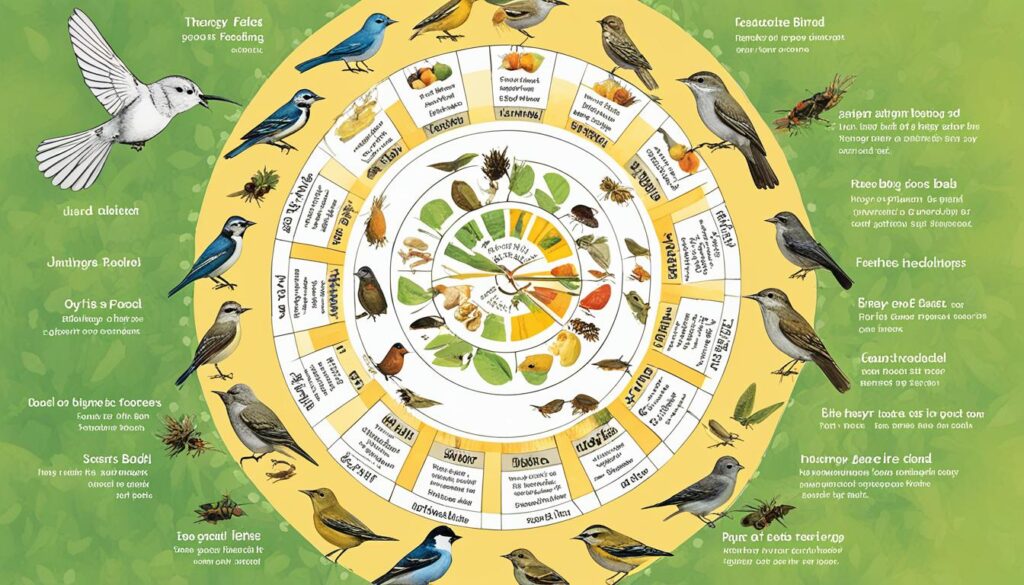
Sticking to these feeding times is vital for baby birds’ health. Those who care for wild birds should be ready to invest the time and effort needed. This ensures young birds grow strong and healthy.
Nutritious Foods for Baby Birds
Is feeding baby birds important for their health and growth? Absolutely, especially when they are nestlings. They need a diet high in protein to grow feathers and muscle. A good diet for them is necessary for their body to get stronger and mature.
High-Protein Diet for Nestlings
Young birds in nests need lots of protein in what they eat. Foods like crickets, mealworms, earthworms, and cooked eggs are great. You can also give them baby bird formulas. Make sure the pieces are small so the birds can eat easily and avoid eating too much at once.
A study showed that nestlings doing best ate food that was at least 25% protein. They grew fast and stayed healthy. Adding a quality baby bird supplement to their meals helps them get all the nutrients they need.
| Nutrient | Percentage in Ideal Nestling Diet |
|---|---|
| Protein | 25-35% |
| Fat | 15-25% |
| Carbohydrates | 40-50% |
Caregivers should watch what nestlings eat and change the amounts they get. This helps baby birds have a strong beginning and a healthy life later on.
“Proper nutrition is the foundation for a baby bird’s growth and development. A high-protein diet rich in essential vitamins and minerals is crucial for their overall well-being.”
Varying the Baby Bird’s Diet
As your baby bird grows up, it will start to look around more. You can slowly change its food to what adult birds eat. This switch is very important for the bird’s health as it starts eating more like adult birds.
For birds that eat insects, try giving them cut-up earthworms, grasshoppers, and crickets. This helps add more protein to their diet. Birds that eat fruit would enjoy berries, grapes, and raisins that have been soaked in water. These foods help them transition to eating what adult fruit-eating birds eat.
- Introduce new food items slowly. This helps the baby bird get used to the change.
- Watch to see how the bird reacts to different foods. This will help you pick the right things to feed it.
- Make sure the food pieces are the right size for the bird to eat easily.
| Food Type | Recommended for Insect-Eating Birds | Recommended for Fruit-Eating Birds |
|---|---|---|
| Protein | Chopped earthworms, grasshoppers, crickets | N/A |
| Fruits | N/A | Berries, grapes, raisins (soaked in water) |
“Gradually transitioning the baby bird’s diet is crucial for its healthy development and successful integration into the adult feeding habits.”
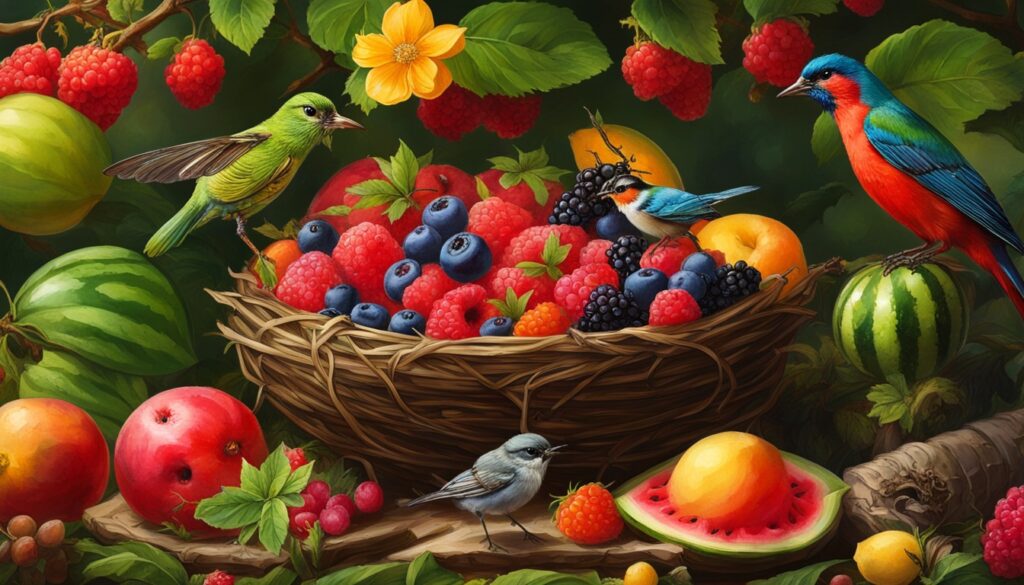
The change to an adult-like diet for the baby bird is a step-by-step process. It needs your patience and careful watching. With a diet that has many different foods, you help the bird grow strong. This prepares the bird to find its own food and live on its own later on.
Special Dietary Requirements
When taking care of baby birds, some types need special food. Doves, pigeons, and parrots aren’t like other baby birds. They need special diets. Talking to a wildlife expert or a bird doctor is key. They can help you give these birds the right special food they need to grow well.
Diets for Doves and Pigeons
Dove and pigeon babies need lots of protein, just like their parents. Their diet should look a lot like what their wild families eat. This means their meals should have seeds, grains, and sometimes bugs. Giving them food that is close to what they would find in nature is the best for their growth and health.
Parrot Chick Nutrition
Parrot chicks have different needs. They need lots of protein, minerals, and vitamins. They should eat a special mix made just for them. This is to be sure they get all they need to grow strong and healthy.
| Metric | Dove and Pigeon Nestlings | Parrot Chicks |
|---|---|---|
| Protein Content | High | High |
| Feeding Frequency | Every 4-6 hours | Every 10-20 minutes |
| Dietary Composition | Seeds, grains, occasional insects | Specialized formula or hand-feeding mix |
| Average Weight Gain | 5-10% of body weight per day | 5-10% of body weight per day |
It’s important to know what each baby bird type needs to eat. This helps them grow well. If you’re unsure, ask a vet or someone who knows about birds. They can tell you what to feed them and how often.
Safe and Unsafe Foods for Baby Birds
Feeding baby birds right is very important to keep them safe. Some foods are healthy for them, but others are not. Knowing what not to feed them keeps them healthy.
Foods to Avoid Feeding Baby Birds
- Bread: Unhealthy, hard to digest, may cause issues.
- Potato Chips: Too much salt and fat are harmful.
- Baked Goods: These are often high in sugar, fat, and salt.
- Honey: Can be harmful if it has spores, leading to “honey bee paralysis.”
- Milk: Baby birds can’t handle dairy, causing tummy troubles.
- Raw Meat: Comes with harmful bacteria, tough to digest.
- Spoiled Seeds: Moldy seeds are toxic, so avoid them.
The right food balance is key for baby bird health. Knowing what’s safe and what’s not helps you care for them well. This knowledge is essential for their proper growth and safety.
| Safe Foods for Baby Birds | Unsafe Foods for Baby Birds |
|---|---|
|
|
Risking less and caring more means avoiding harmful foods. A proper diet keeps baby birds in great health. With a little care, you can help them grow strong.
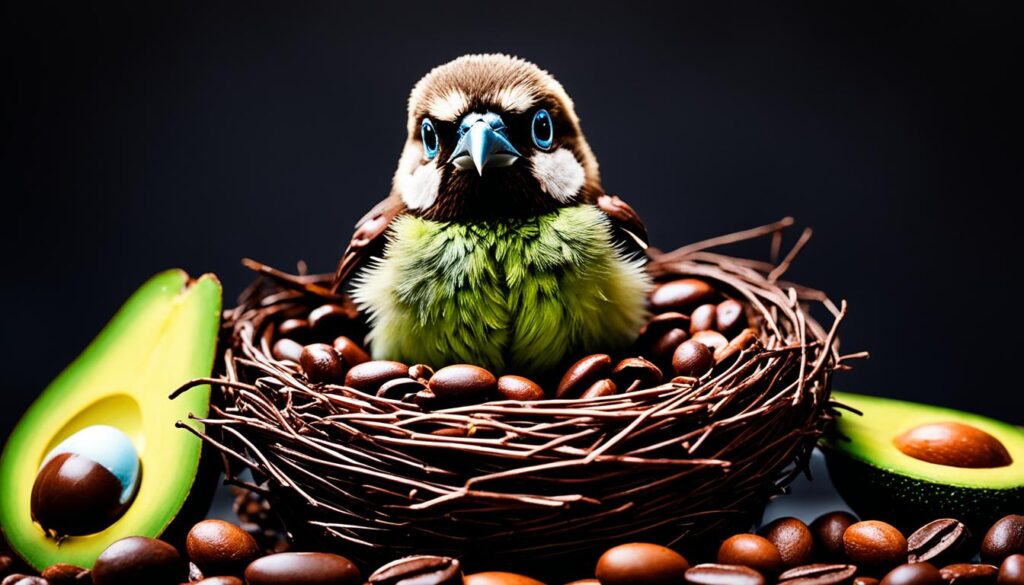
“The health and safety of baby birds should be the top priority when it comes to their diet. Avoiding potentially harmful foods is just as important as providing the right nutrients.”
what do baby birds eat?
Understanding the dietary needs of baby birds is key. Nestlings are almost featherless and need their parents completely. They eat differently from fledglings, which are older and have some feathers.
When they are still nestlings, they need lots of protein for their fast growth. They eat bugs, fully cooked eggs, and special formulas for baby birds. These foods are packed with nutrients to help them grow.
Later, as fledglings, young birds can eat more types of food. Introducing new foods slowly helps them learn how to find food on their own. It also helps them get used to their surroundings.
Making sure baby birds get the right food is very important. Knowing what nestlings and fledglings need can help us take care of them. This way, they can become healthy adult birds.
baby bird diet can guide you for more information.
Nestling Food Sources
- Insects
- Fully cooked eggs
- Specialized baby bird formulas
Fledgling Diet
- Gradual introduction of diverse food sources
- Development of natural foraging instincts
- Adaptation to the environment
“Proper nutrition is essential for the healthy development of baby birds.”
Proper Feeding Techniques
Feeding baby birds needs careful effort to keep them safe and help them grow well. The main point in feeding baby birds is to be precise and make their food correctly. By doing this, you make sure your baby bird gets all it needs.
Food Preparation and Serving Tips
The food should be soft and not too hot or cold. These temps could hurt the little bird. It’s also key to prepare the food carefully to avoid choking. You might need to cut up bugs, soften dry food, or mix a special formula.
Feeding the bird should be at its speed. Don’t force the bird to eat. It can harm the bird. Let the bird choose when to eat. Also, give the food in small bits. Overfeeding can cause tummy problems.
- Serve food at room temperature to avoid harming the bird
- Prepare food carefully, like cutting up bugs or softening dry food
- Let the bird eat at its own speed, without pushing its beak open
- Feed the bird small amounts to avoid tummy troubles
Sticking to these feeding and preparation tips makes feeding stress-free. Your baby bird will grow healthy and strong with the right care.

Transitioning to Self-Feeding
As baby birds get stronger and grow their feathers, they need to start eating on their own. This step is vital as it gets them ready to fly solo in the wild. It involves giving them food less often and in small amounts in their space. This way, they learn to feed themselves and get used to the independence they’ll soon have.
This change is closely watched since each bird type has unique feeding needs. For example, songbirds need food every 15 to 30 minutes all day long. Raptors, on the other hand, have different diets. So, it’s crucial to adjust the feeding plan to fit each bird’s needs.
- Start feeding the baby bird less often, so they have to find and eat food on their own.
- First, forget about the morning feeding and then slowly reduce the formula amount. This helps the bird switch to solid food.
- Next, cut out night feedings and then move to stop all formula feedings. This pushes the bird to eat solids fully.
- Give the bird water to make up for the moisture in the formula it’s not getting anymore.
- Watch the bird’s weight and health closely, and change the feeding plan as required.
The exact time to start this transition changes with the bird type. Generally, songbirds become independent in about two weeks. Others might need more time. Caregivers watch for signs that the bird is ready and tweak the feeding plan. This ensures a good weaning.
When birds are fully feathered and eating on their own, they’re ready for an outdoor space. This gets them used to living outside, softly releasing them into the wild. The bird can leave the enclosure when it wants. This method helps the bird smoothly adjust to its natural life again.
Caring for a Baby Bird’s Overall Well-being
Caring for a baby bird is more than just giving it food. It’s vital to look after its total well-being. This means keeping it safe from harm, making sure it’s the right temperature and humidity. It’s also important to reduce stress.
It’s a good idea to check on the baby bird often and talk to those who know about wildlife. If you don’t take good care, the bird could get sick or not grow well. Knowing what to do and having the right tools is key when caring for a wild bird.
Protecting from Predators
Baby birds can be easy targets for many animals. You must keep them safe in a place where they can’t be reached. Make sure the area is secure and away from pets like cats and dogs.
Maintaining Temperature and Humidity
The baby bird’s room must be the right temperature and humidity for it to be healthy. Keep it warm, around 105°F to 110°F, and the air moist. Checking on these conditions and adjusting them when needed is crucial.
Minimizing Stress
Stress is very bad for a baby bird and can make it very sick. To avoid stress, handle it as little as possible. Give it a good place to stay and make sure its food is always warm and fresh. Try not to disturb it and keep its space quiet and comfy.
Taking care of a baby bird includes many tasks. You need to keep it safe, make the right environment, and keep it stress-free. With proper care, you can help the bird grow well and have a better chance of surviving.
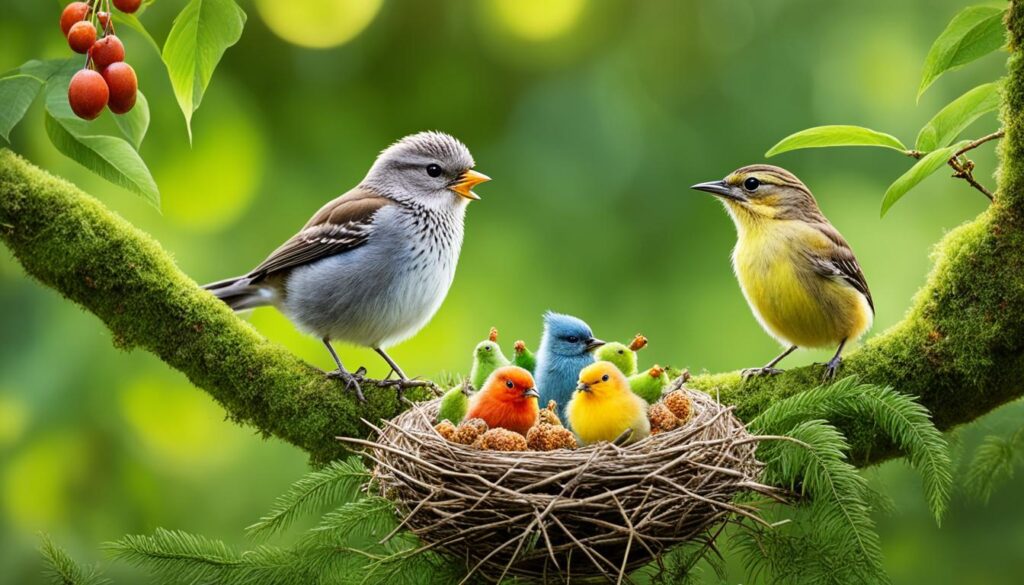
Conclusion
Looking after baby birds is a careful job that needs knowledge, patience, and lots of care. You must know what baby birds eat, give them the right food, and keep them well. This way, they have a better chance of growing strong and flying free. It’s smart to get advice from wildlife experts and bird centers for the best care.
This guide shows why good food matters so much for baby birds. They need a diet that’s full of proteins, fats, and the right nutrients. Bad foods like sugary snacks can hurt them. It’s also key to feed them at the right times and learn how to hand-feed them properly.
Taking care of baby birds is an important job that we can do. By doing what this guide says and getting help when needed, bird lovers can help these tiny creatures. This helps protect different types of birds, making a big difference in their survival.
FAQ
What do baby birds eat?
Baby birds need a special diet that changes as they grow. Nestlings, the youngest birds with few feathers, eat a lot of protein. They should be fed insects, fully cooked eggs, and special baby bird food. Fledglings, older birds with grown feathers, will start eating a wider variety of foods as they grow.
How do I identify if a baby bird needs help?
First, figure out if the baby bird is a nestling or a fledgling. Nestlings are very young and mostly naked. They may need help as they can’t care for themselves. Signs they need help include being alone, weak, or if their parents don’t come to feed them.
How can I reunite a baby bird with its nest?
If the baby bird is a nestling, try to put it back in its nest. Find the nest in a tree or bush nearby. Gently return the baby to its nest and move away. Birds can’t smell well, so they won’t mind your scent on the baby.
What if I can’t find the original nest?
You can make a new nest with a berry basket or butter tub. Line it with paper towels. Put the baby birds in it and hang it in a tree or bush close to where you found them. This gives their parents a chance to care for them.
What if I can’t reunite the baby bird with its nest?
If you can’t get the baby bird back with its family, call a bird rehab or a wildlife rescue. They can give the bird the care it needs. They know how to help birds like this.
How often should I feed a baby bird?
Very young birds need food every 15-20 minutes while the sun is up. As they get older, you can feed them every 30-45 minutes. You’ll feed them less often as they learn to find food on their own.
What are the best foods for baby birds?
Baby birds need a diet rich in protein for fast growth. Give them small insects, chopped worms, cooked eggs, and special baby bird food.
Can I feed my baby bird human foods?
Not all human food is good for baby birds. Some things like bread, potato chips, baked goods, honey, milk, raw meat, and bad seeds can be dangerous. It’s important to feed them things that are healthy and safe.
Do all baby birds have the same dietary requirements?
No, different birds might need different foods. Birds like doves, pigeons, and parrots might need special diets that are not the same as typical baby birds. A bird expert can help make sure these birds get the right food.
What are the proper techniques for feeding a baby bird?
When you feed baby birds, make sure the food is soft, warm, and easy to eat. Don’t force their beaks open. Let them eat at their own pace. It’s also important to prepare the food correctly; for example, chop up insects and make dry food soft, to make sure they don’t choke.
